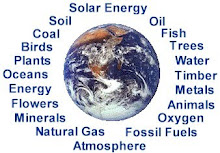NATURAL RESOURCES.....
Natural resources (economically referred to as land or raw materials) occur naturally within environments that exist relatively undisturbed by mankind, in a natural form. A natural resource is often characterized by amounts of biodiversity existent in various ecosystems.
Natural resources are derived from the environment. Many of them are essential for our survival while others are used for satisfying our wants. Natural resources may be further classified in different ways.
Natural resources are derived from the environment. Many of them are essential for our survival while others are used for satisfying our wants. Natural resources may be further classified in different ways.
CLASSIFICATION OF NATURAL RESOURCES....
On the basis of origin, resources may be divided into:
- Biotic - Biotic resources are the ones which are obtained from the biosphere. Forests and their products, animals, birds and their products, fish and other marine organisms are important examples. Minerals such as coal and petroleum are also included in this category because they were formed from decayed organic matter.
- Abiotic - Abiotic resources comprise of non-living things. Examples include land, water, air and minerals such as gold, iron, copper, silver etc.
Considering their stage of development, natural resources may be referred to in the following ways:
- Potential Resources - Potential resources are those which exist in a region and may be used in the future. For example, mineral oil may exist in many parts of India having sedimentary rocks but till the time it is actually drilled out and put into use, it remains a potential resource.
- Actual Resources are those which have been surveyed, their quantity and quality determined and are being used in present times. For example, the petroleum and the natural gas which is obtained from the Bombay High Fields. The development of an actual resource, such as wood processing depends upon the technology available and the cost involved. That part of the actual resource which can be developed profitably with available technology is called a reserve.
With respect to renewability, natural resources can be categorized as follows:
- Renewable Resources - Renewable resources are the ones which can be replenished or reproduced easily. Some of them, like sunlight, air, wind, etc., are continuously available and their quantity is not affected by human consumption. Many renewable resources can be depleted by human use, but may also be replenished, thus maintaining a flow. Some of these, like agricultural crops, take a short time for renewal; others, like water, take a comparatively longer time, while still others, like forests, take even longer.
- Non-renewable Resources - Non-renewable resources are formed over very long geological periods. Minerals and fossils are included in this category. Since their rate of formation is extremely slow, they cannot be replenished once they get depleted. Out of these, the metallic minerals can be re-used by recycling them. But coal and petroleum cannot be recycled.
The conservation of natural resources is the fundamental problem. Unless we solve that problem, it will avail us little to solve all others.
~Theodore Roosevelt~By :
UMI NADIAH (D20061026129)






No comments:
Post a Comment